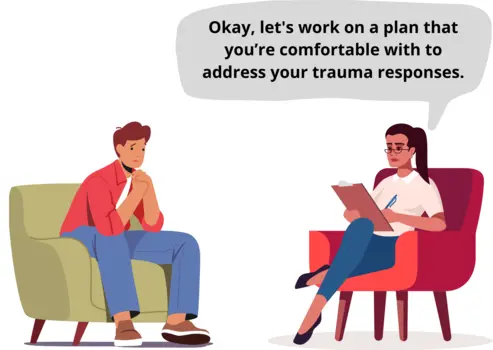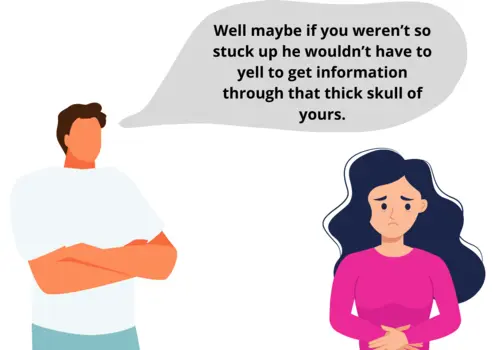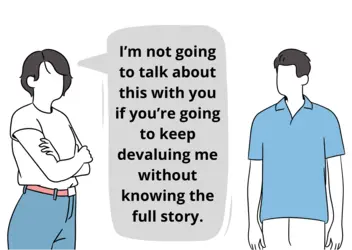Breaking a trauma bond doesn’t happen overnight. It often takes victims of abuse years to completely dismantle the manipulative structure that their abuser created so that they can rebuild the healthiest version of themselves. But there are a handful of signs that victims of abuse can look out for that indicate that their trauma bond is coming to an end.
Seven reliable signs that a trauma bond is over are when the victim stops looking at their abuser’s social media, ruminates less, moves forward with their life, learns how to handle flying monkeys and abuse enablers, regains control of their health, and turns their trauma into a learning experience that keeps them out of harm’s way.
This article is going to guide you through each of those signs so that you can fully understand how they signify the end of a trauma bond. Sadly, experiencing a trauma bonded relationship corrupts your definition of a healthy relationship which makes you vulnerable to falling into another abusive relationships so we’ve created a short video packed with important information about preventing trauma bonds before they even start to help you be the best version of yourself!
A Short Video With Important Information About Preventing Trauma Bonds Before They Start!
You Stop Checking Up on Your Abuser on Social Media
One of the hardest parts of breaking a trauma bond is having them discard you and move on with their new supply disturbingly fast. You can’t help but question if every invalidating, devaluing, condescending, and dehumanizing thing that your abuser said about you is true because they have already moved on with someone who makes them so happy while you’re left broken, confused, and hurt.
It’s very common for trauma bonded victims of abuse to use social media to check up or subtly reach out to their abuser when they’re feeling confused and hurt. This could be by simply scrolling through their page or it could be posting pictures, quotes, videos, and so on, to attempt to get the attention of their abuser. A very good sign that the trauma bond is over is that you’ve stopped this behavior, maybe even blocked them on all platforms, and are beginning to move on with your life!

You Ruminate About the Abuse Less
When your mind becomes consumed with excessive and intrusive thoughts about negative experiences and feelings, it is called rumination. It is very common to see victims of abuse have ruminating thoughts about the abuse they experienced.
However, it is also extremely dangerous. It keeps victims of abuse trapped within the abuse cycle, fosters an insane amount of negative emotions like self-doubt and self-blame, and prevents them from taking care of their health, being there for the people who truly love them, and taking steps forward on the healing journey.
Less and less rumination is a really good sign that the trauma bond is coming to an end and that you’re in a mental space where you can ensure that you have a safe healing journey. If you have problems with rumination, please skip over to our article How to Stop Ruminating After Narcissistic Abuse for a thorough guide through the confusion.
You Develop Healthy Trauma Responses
After months, years, or even decades of abuse, you can expect to experience a lot of trauma responses. A trauma response is simply an emotional response to trauma and there are four types of them: flight, fight, freeze, and fawn.
Flight
A flight trauma response is when someone literally or figuratively runs away from the trauma in their life. For example, someone who dives into their work instead of addressing the trauma that they have from years of domestic violence is figuratively running away from their trauma.
If someone were to get up and run out of a restaurant where they were eating with a friend because their emotionally abusive ex-partner walked into the establishment, that would be a flight response.

Fight
A fight response originates from one’s belief that having power and control over others is the best way to accumulate love, acceptance, and safety. The fight response is a very narcissistic response so the example below is just for information, it isn’t meant to suggest a victim of abuse would respond in this manner.
Imagine that someone flew into a narcissistic rage and smashed out the car windows of a girl who rejected his prom proposal, that would be an example of a fight response.
Freeze
The freeze response is a manifestation of someone being caught between the fight response and the flight response. When someone responds to trauma by freezing they are very aware of their surroundings and are trying to gather enough data to make a decision about what they should do next.
For example, if a victim of abuse remained stopped at a light even though it had turned green because he saw his abusive ex-partner drive past him with her new source of supply, that would be a freeze response.
Fawn
The fawn response is when people escape trauma with a variety of people pleasing behaviors. For example, if an abuser began to ridicule, bully, and devalue his victim because she forgot to get beer on her way home from her double-shift that she has to work because the abuser’s business put the family in a tremendous amount of debt, a fawn response would be if she became incredibly apologetic, agreed with his abusive comments, and drove back to the store to pick up the beer.
A qualified professional is going to be able to help you create a plan to manage these deeply rooted psychological responses to trauma but once you do find a way to do so, it is a very good sign that you’re breaking the trauma bond.

You Become Comfortable Moving Forward With Your Life
One of the things that happen to trauma bonded victims of abuse is that they’re gaslighted, invalidated, devalued, dehumanized, and confused so frequently throughout the entirety of their relationship that they become incapable of conceptualizing a sense of self without the abuser’s opinion.
This means that the victim is manipulated into neglecting their own thoughts, feelings, needs, and emotions to ensure that the abuser gets enough validation, admiration, and reassurance. The victim will abandon their core values, dreams, and goals in life to make sure that their abuser has everything that they need in life.
The victim will end up stuck in a position where they can’t move forward in life because their abuser won’t let them and they can’t move backwards in life, emotionally checkout of the relationship, because they would no longer be a viable source of validation, admiration, and reassurance which would cause them to be discarded, so they just remain stuck in a deeply unsatisfying space with nowhere to go.
It’s for this reason that feeling comfortable moving forward with your life is a huge sign that you’ve broken the trauma bond and are on your way to a healthy, happy, and secure future.
This could manifest in the form of finishing school, getting the job you’ve always wanted, chasing a goal you have, feeling comfortable in your own skin, etc.. Whatever it may be, being comfortable with moving forward in your life is a good sign that the trauma bond is coming to an end.
You Learn How to Manage Flying Monkeys and Enablers of Abuse
A flying monkey is someone that an abuser will manipulate into participating in their smear campaign of the victim. Flying monkeys have been known to abuse the victim, manipulate the victim into giving the abuser another chance, invalidate and devalue the victim, and much more.

An enabler is someone who doesn’t understand the concept of abuse and toxic relationships so they approach the situation as they would a healthy relationship. This leads to the enabler giving horrible advice, accidentally gaslighting the victim, accidentally invalidating and devaluing the victim, and to many more ignorant behaviors.
Both a flying monkey and a narcissist enabler have the potential to push the victim back into the abuse cycle but what makes them so traumatizing is that they’re often people who the victim once confided in.
Isolation from friends and family is a core dynamic of abusive relationships and how abusers remain in power and control. They will often spread lies, gossip, use their manipulative behaviors, and superficial charm to trick the friends and family members into becoming flying monkeys and enablers.
This makes breaking a trauma bond and healing from abuse incredibly difficult because it can take awhile for one to realize that even though the flying monkeys and enablers are those they once confided in, their ignorance is just as dangerous as the abuser’s abuse.
Breaking a trauma bond and healing from abuse requires victims of abuse to physically and/or emotionally cut the abuser and the extensions of the abuser out of their lives so learning and understanding how to manage flying monkeys and enablers is a fantastic sign that one is breaking the trauma bond and healing from the abuse.

You Regain Control of Your Physical and Mental Health
As we mentioned before, abusers are very good at manipulating their victims into neglecting their own thoughts, feelings, emotions, and needs on a daily basis to ensure that the abuser gets enough validation, admiration, and reassurance. What this often leads to is the deterioration of the victim’s mental and physical health that can lead to the victim having headaches, digestive issues, high levels of anxiety, physical illnesses, muscle cramps, and so on.
4 Common Health Related Topics That Can Get Neglected Because of Abuse:
- Daily Practices
- These are little things you do every single day to acknowledge the things of importance to you. This could be writing in a journal, going on a walk, yoga, reading, spending time with your kids, watching your favorite TV show/movie, avoiding alcohol and other substances, learning something new and so on.
- Preventative Health Care
- Preventative health care includes things like cancer screenings, diabetes screenings, cholesterol tests, mental health screenings, blood pressure tests, well-child visits, STI screenings, and routine vaccinations.
- Medication Adherence
- The U.S. Food and Drug Administration (FDA) states,
- “Medication adherence, or taking medications correctly, is generally defined as the extent to which patients take medication as prescribed by their doctors. This involves factors such as getting prescriptions filled, remembering to take medication on time, and understanding the directions.”
- The U.S. Food and Drug Administration (FDA) states,
- Daily Preventative Behaviors
- These are things you should do on a daily basis to keep yourself healthy. Given the current situation with the pandemic, daily preventive behaviors refers to things like washing your hands, social distancing, wearing a mask in public, minimizing the amount of times you touch your face, being responsible when coughing/sneezing, using hand sanitizer and so on.
The more work that you do with yourself and/or with a qualified therapist to unpack the trauma you experienced the more comfortable you’re going to become with putting yourself first. Regaining control of your health is a really good sign that you are breaking the trauma bond and healing from the abuse.
You Are Able to Turn Your Trauma Into a Learning Experience
It’s a beautiful moment when victims of abuse begin to understand the abuse they experienced instead of wondering why they experienced the abuse. It takes a lot of hard work, self-reflection, self-awareness, sacrifice, and dedication to truly sift through the complexity of abuse in a way that allows you to grasp a comprehensive understanding of it.
But when you do, it is going to introduce you to an entirely different way of life. You’re going to be able to effortlessly set and maintain healthy boundaries, you’re going to stop feeling like you have to constantly walk on eggshells around other people, you’re going to be able to see the warning signs of abusers, and you’re going to become indifferent to the trauma that trapped your body and mind inside the abuse cycle.
At times, learning about abuse can be extremely triggering. But once you understand what you experienced and why, you are going to be able to become the happy, healthy, and secure person that you always had inside you.
Becoming knowledgeable about abuse and using that information to help yourself and others is one of the most powerful signs of growth, healing, and a trauma bond being broken.
About the Author

Hey, I’m Elijah.
I experienced narcissistic abuse for three years.
I create these articles to help you understand and validate your experiences.
Thank you for reading, and remember, healing is possible even when it feels impossible.
References:
Reid, Joan, et al. “Trauma bonding and interpersonal violence.” Psychology of trauma (2013).
